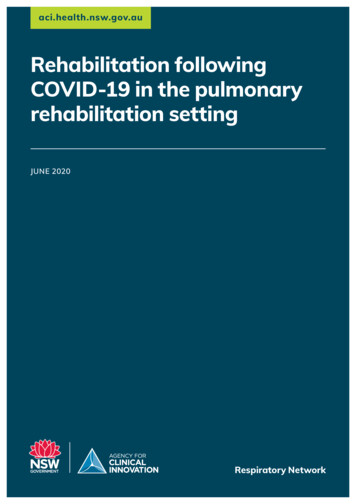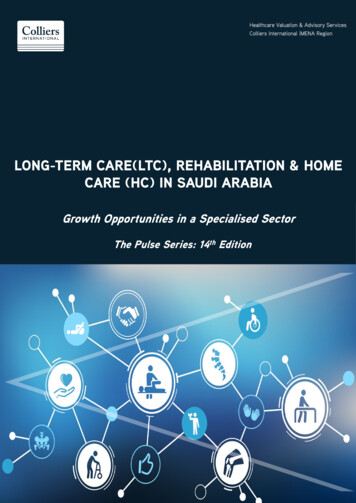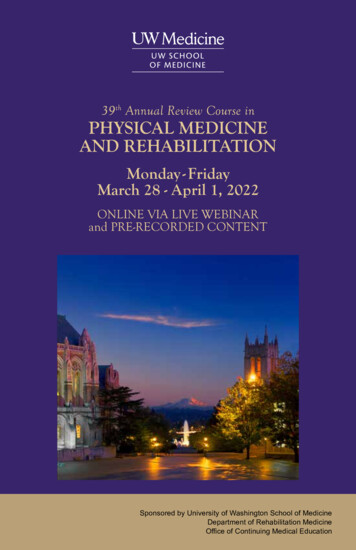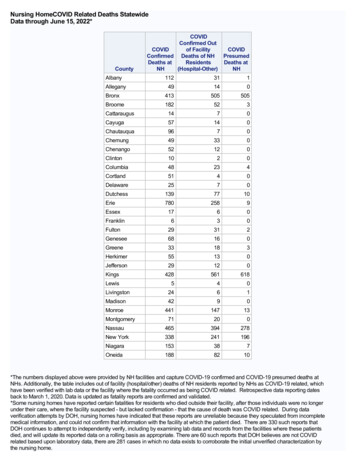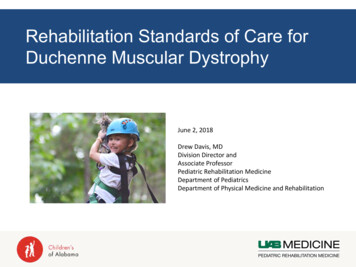
Transcription
Rehabilitation Standards of Care forDuchenne Muscular DystrophyJune 2, 2018Drew Davis, MDDivision Director andAssociate ProfessorPediatric Rehabilitation MedicineDepartment of PediatricsDepartment of Physical Medicine and Rehabilitation
Objectives-Review 2018 Duchenne muscular dystrophy (DMD) careconsiderations for rehabilitation-Review overlapping components of care related toorthopedic management-Review local resources that support rehabilitation careconsiderations and support individualized goals
Pediatric Rehabilitation Medicine Pediatric Rehabilitation Medicine (PRM)– utilizes an interdisciplinary approach– address the prevention, diagnosis, treatment, andmanagement of congenital and childhood-onset physicalimpairments including related or secondary medical,physical, functional, psychosocial, cognitive, andvocational limitations or conditions– an understanding of the life course of disability
Duchenne Muscular DystrophyDMD results in:- progressive muscle degeneration and weakness- postural compensations- risk of progressive contracture and deformity- functional losses
Duchenne Muscular DystrophyImproved DMD management has resulted in:- prolongation of ambulation- decreased prevalence of severe contracture anddeformity, including scoliosis- prolonged function and participation in all areas of life
Duchenne Muscular DystrophyBirnkrant, David J (03/2018). "Diagnosis and management of Duchenne muscular dystrophy, part 1: diagnosis, and neuromuscular,rehabilitation, endocrine, and gastrointestinal and nutritional management.". Lancet neurology (1474-4422), 17(3), p. 251.
Duchenne Muscular DystrophyRehabilitation team members include:- Physicians- Physical therapists- Occupational therapists- Speech-language pathologists- Orthotists- Durable medical equipment providers- Others
Duchenne Muscular DystrophyThe rehabilitation team focuses on:- Individual’s goals and lifestyle to optimize quality of life across thelifespan- Assessment and anticipatory managementWith the goal of minimizing :- contractures- deformity- loss of function- compromised skin integrity- pain- compromised cardiorespiratory status
AssessmentMultidisciplinary rehabilitation assessment includes:- measures of passive ranges of motion- muscle extensibility- posture and alignment- strength- function- quality of life- participation in all normal activities of everyday life
AssessmentSpecialized functional assessment may include:- Analysis of patterns of movementex. 6-minute walk test (6MWT)- Standardized assessments specific to DMDex. North Star Ambulatory AssessmentGoal:- Predictive capabilities regarding functional motor changes that are important inmonitoring clinical progression- Assessing new and emerging therapies
AssessmentLimitations and considerations:- Prediction of functional change in clinical settings should be made in the contextof a patient’s capabilities- Awareness of limitations in effort-based assessments- Potential interactions with musculoskeletal impairments such as contracture, andgenetics- Tests that predict potential upcoming changes can be used to guide proactivecare, such as impairment-level interventions and future equipment needs
AssessmentExample:- Before age 7 years, gains might occur in the 6-min walk test and timed functiontests.- After age 7 years,- a 6-min walk test result of less than 325 m,- time to stand more than 30 sec,- time to climb four stairs more than 8 s,- 10-min walk or run time more than 10–12 s,- Mean linearized NSAA 34 or less- Have all been associated with greater functional decline inambulation over the subsequent 12 months.
Assessment-Functional assessment includes the assessment of activities of daily living and the need foradaptive equipment or assistive technology.-Various tools can be used to assess quality of life.-Increasing use of standardized testing in infants and young children with DMD is timely-potential for early diagnosis with newborn screening-emergence of therapies that might work best if used in earlychildhood.
Assessment-Consistent use of the same functional measures by individual clinics is recommended fortracking change over time-Assessment by rehabilitation specialists is recommended at least every 4–6 months throughoutlife-More frequent assessment triggered by a clinical concern, a change in status, or specificneeds.
Intervention-Physical, occupational, and speech and language therapy- Outpatient- School- Hospital admissions- Home-Continue throughout adulthood
Targets of Intervention-The goal of muscle extensibility and joint mobility management is to prevent or minimizecontracture and deformity caused by:-inability to move a joint through its full range of motion-chronic static positioning-muscle imbalance about a joint-fibrotic changes in muscles-Restricted patterns of breathing and fibrosis of intercostal muscles decrease chest wall mobility.
Intervention-Maintenance of passive ranges of movement, muscle extensibility, chest wall mobility, and symmetrycan:-optimize movement and functional positioning-maintain ambulation-prevent fixed contractures and deformities-optimize respiratory function-maintain skin integrity-Musculoskeletal management requires a team approach with input from:- neuromuscular specialists- physical therapists- occupational therapists- rehabilitation physicians- orthotists- orthopedic surgeons
InterventionPrevention of contracture and deformity requires:-daily passive stretching of joints, muscles, and soft tissues at risk of tightness.- support of movement by decreasing the effects of gravity and optimizing biomechanicsto allow more active movement.- manual therapy techniques and prolonged elongation of soft tissues.- optimal positioning, including individualized use of splinting, orthotic interventions,standing devices, serial casting, and custom seating and power positioning componentsin mobility devices.
Intervention- A daily preventive home stretching program should begin before the loss of passive ranges of motionunder the guidance of physical and occupational therapists.- Stretching is recommended for areas known to be at risk of contracture or deformity.- Regular stretching of ankle, knee, and hip should begin soon after diagnosis and continue intoadulthood.- Stretching of the upper extremities is especially important after loss of ambulation.
Intervention- Orthotic intervention, splinting, casting, positioning, and equipment:-AFOs for stretching at night (might be best tolerated if startedpreventatively at a young age)- AFOs for stretching or positioning during the day in non-ambulatory phases- Wrist or hand splints for stretching of long and wrist finger flexors/extensors, typically innon-ambulatory phases- Serial casting-in ambulatory or non-ambulatory phases
Intervention-Orthotic intervention, splinting, casting, positioning, and equipment:- Passive/motorized supported standing devices—when standing in good alignmentbecomes difficult, if contractures are not too severe to prevent positioning or tolerance- KAFOs with locked knee joints—an option for late ambulatory and non-ambulatorystages- Custom seating in manual and motorized wheelchairs (solid seat, solid back, hip guides,lateral trunk supports, adductors, and head rest)- Power positioning components on motorized wheelchairs (tilt,recline, elevating leg rests, standing support, and adjustable seat height)
Intervention- Power stand-and-drive motorized wheelchairs are now frequently used in place of knee-ankle-footorthoses to support standing mobility.- KAFOs might still be an appropriate choice in some situations, but should be viewed as therapeuticrather than functional tools, supplementing rather than replacing motorized mobility.- Technological innovations may be simple or advance- Simple devices- elevated lap trays and- adaptive straws) to more- Advanced technologies- robotics- bluetooth capabilities that permit remote activation of devices- infrared environmental controls- smart phones- tablets and computers- advanced access capabilities such as voice activation in the home
Intervention- Possible adaptive equipment and home renovations include:- lifts for safe transfers- ramps- stair lifts- bathing and bathroom equipment or renovations- special beds and mattresses- vehicle modifications- Personal care attendants can help to optimize independence and participation.
Intervention- Physical therapists prescribe, monitor, and guide exercise, which can prevent an unnecessarilysedentary or immobile lifestyle and the associated problems of social isolation and overweight.- The effects of exercise on muscle degeneration in dystrophinopathies, though not fully understood,can include damage due to structural fragility of muscles, metabolic abnormalities, nitric oxideabnormalities contributing to ischemia during exercise, and reduced exercise capacity.- Eccentric muscle activity or exercise and high-resistance exercise or strength training should beavoided.- Submaximal aerobic exercise or activity has been recommended, especially early in the course of thedisease - avoiding overexertion and overwork, and allowing adequate rest.
Intervention- Swimming is highly recommended from the early ambulatory stage and can befrequently continued adulthood.- Cycling has been recommended as a submaximal aerobic form of activity andassisted cycling and robotic-assisted movement can be used into adulthood.
Intervention- Safe physical activity can be supported by appropriate adaptive equipment and assistive technology.- Pain must be assessed and addressed in individuals at all ages.- Interventions require comprehensive team management, including physical therapy, posturalcorrection, orthotic intervention and splinting, wheelchair and bed enhancements that allowindependent weight shift, position change and pressure relief, and pharmacological approaches.- Back pain, particularly in the context of glucocorticoid treatment, should prompt assessment forvertebral fractures.
Orthopedic Intervention- Children in the ambulatory stage might benefit most from surgery, but it isrecommended less frequently than in the past.- Though the 2010 care considerations included recommendations for multilevelsurgeries, the consensus of the current panel is that surgery on the foot toimprove the varus positioning and on the Achilles tendon to improvedorsiflexion range might be sufficient to improve gait in patients with clinicallysignificant ankle contracture and good quadriceps and hip extensor strength.- Interventions related to the hips and knees are not recommended.
Orthopedic Surveillance- Assessment for scoliosis should be done at least annually, although onset isunusual in the ambulatory stage.- Visual assessment is appropriate, with radiographic assessment only if a curveis observed on examination or if visual inspection alone is inadequate, such as inchildren with obesity.- Use of spinal orthoses is not generally recommended in the setting of acompression fracture.
Orthopedics - Fractures- Anticipatory guidance during routine clinic visits is an important part of a fractureprevention program throughout all disease stages.- Corticosteroids have been associated with osteoporosis and subsequent vertebralfractures in DMD.- In a study of 143 boys with DMD, the long-bone fracture rate in those treated withcorticosteroids was 2-6 times greater than in those who had never receivedsteroids.- A lower-limb fracture during the ambulatory stage might need aggressivemanagement to maintain ambulation.- Internal or external fixation allows for early mobilisation compared with casting orsplinting.
Fracture Prevention
OrthopedicEarly non-ambulatory stageFoot and ankle surgery to improve equinovarus foot might help with footpositioning in the wheelchair or for shoe wear, but is typically done only if apatient requests the procedure.After foot and ankle surgery, use of ankle-foot orthoses will be needed duringthe daytime to prevent a recurrence of the contractures.
Orthopedic- Inspection of the spine should be part of every clinical examination.- Experienced clinicians should be able to monitor the spine in non-ambulatoryboys by visual inspection alone; however, less experienced clinicians shouldobtain a spine radiograph when a child first becomes non-ambulatory.- A spine radiograph is also useful when inspection is unhelpful, such as inchildren with obesity.
Orthopedic- Once a curve has been detected with radiography, further surveillance dependson the skeletal maturity:- skeletally immature individuals should undergo radiographs onceevery 6 months, and- skeletally mature individuals should undergo radiographs at leastonce a year.- A curve of 20 or more should warrant involvement of an orthopedic surgeon.- The use of spinal orthoses is not recommended.- Those treated with corticosteroids have milder spinal curvatures and lessfrequent need for spinal surgeries.
Orthopedic- Posterior spinal fusion in young men with DMD is recommended due to thepositive effect on:- function,- sitting balance and tolerance,- pain, and- quality of lifeObserved in non-randomized, prospective cohort studies.
Orthopedic- Posterior spinal instrumentation and fusion are recommended in:- non-ambulatory individuals- with a spinal curve in the sitting position greater than 20-30 ,- who have not yet reached puberty, and- who have not been treated with corticosteroids (because the curveis expected to progress).- Although patients treated with corticosteroids can still develop scoliosis,the progression might be less predictable, so observation for clear evidenceof progression is a reasonable approach before intervening.
Orthopedic- Anticipatory fracture prevention guidance should continue through the nonambulatory stages.- A more conservative approach to management of lower-limb fractures isadvised in non-ambulatory children because the goal is no longer to bearweight.- Internal fixation might be necessary for an unstable fracture, but splintingmight be sufficient for bone healing and pain control.
Orthopedic- Surgical interventions to manage contractures involving the upper or lowerextremities are not recommended during the late non-ambulatory stage ofDMD unless there problems with:- pain- Positioning- skin integrity
Orthopedic- Individuals with known scoliosis should have yearly anteroposterior uprightspinal radiographs when there is any concern about progression.- Posterior spinal fusion is recommended during the late non-ambulatory stagefor those with a progressive curve.- It is essential to consult with the patient’s respiratory physician andcardiologist to ensure that lung and heart function are sufficient to proceedwith this surgical intervention.- Some studies indicate that spinal fusion slows the progression of respiratorydecline, whereas others show no significant difference in the rate of declinepostoperatively.
PartnersTeamwork is the ability to work as a group toward a common vision, even if that visionbecomes extremely blurry.-Unknown Author
Partners
Rehabilitation Standards of Care forDuchenne Muscular DystrophyThank you!
becomes difficult, if contractures are not too severe to prevent positioning or tolerance - KAFOs with locked knee joints—an option for late ambulatory and non-ambulatory stages - Custom seating in manual and motorized wheelchairs (solid seat, solid back, hip guides, lateral trunk supports, adductors, and head rest)







